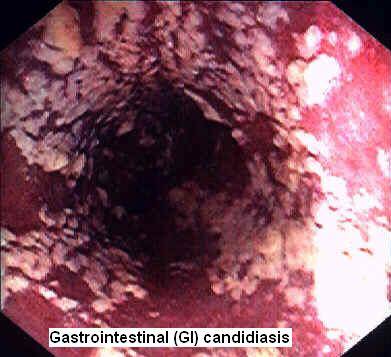
Tests for systemic Candida Albicans
Commonly referred to as a yeast infection or thrush. Candidiasis is a fungal infection (mycosis) of any of the Candida species. Other technical names for candidiasis include candidosis, moniliasis and oidiomycosis. The most prevalent species involved in yeast infections is C. Albicans.
| Candida Albicans | ||
|---|---|---|
|
As a controlled population, the yeast form of Candida Albicans and other species is a normal part of the digestive tract flora(non-parasitic organisms that live inside our mouth, throat, intestines and genitouriniary tract, such as L. acidophilus, B. bifidum, L. bulgaricus, S. thermophilus and L. salivarius) - One of Candida's functions is to recognize and destroy pathogenic bacteria - Candida does not like an acid environment - Candida thrives in damp, moldy places and after consumption of foods rich in carbohydrates - such as sugars, refined carbohydrates and starches. When its numbers get out of control, it is the most frequent of the yeast fungi to cause damage, which can affect the whole body -some experts estimate that ~ one third of the industrial nation populations suffer from diseases attributed to candida albicans ! (Yeast represents only 1% of fungal species); |
||
The common unicellular yeast form of candidiasis
Yeast appears as a whitish plaque, discharge or rash
Is limited to mucosal membranes in the mouth or vagina. It is usually easy to cure in people who are not immuno-compromised;
High risk groups. Include newborns and adults over 65 years;
Vaginal thrush can be caused by frequent vaginal douching (in addition to the causes mentioned above). This disturbs vaginal pH, increasing risk of yeast infection.
Tips to prevent the progression from this level to the next more aggressive level
- Oral hygiene is crucial. To remove the candida and prevent the yeast from becoming more aggressive, which can happen over a period of years. Remember to brush your tongue, and rinse your mouth with an anti-fungal solution (E.g. 3% hydrogen peroxide),as well as brushing your teeth.
- Ensure your body is well-stocked with probiotics. E.g. by either taking a good probiotic supplement or eating a daily serving of an organic, multi-strain, live-culture yogurt, containing around 20 billion organisms. This will increase intestinal acidity, which deters Candida.
How to increase body's probiotic presence

C. Albicans in oval yeast form (no hyphae)
With a weakened immune system, Candida albicans can overgrow and change into an aggressive fungus
In this aggressive form, Candida sprouts long root-like rhizoids. These are called hyphae, which Candida uses to anchor to mucous membranes, such as mouth, vagina, sinuses, ears, nasopharynx, respiratory system, genitourinary tract, warm moist skin areas (incl. under finger and toe-nails) and the GI tract lining.
Symptoms. Include reoccurring ulcers, red patches, painful sores
"Leaky Gut Syndrome" Mycelial Candida makes microscopic holes in the gut lining, through which large food molecules, bacteria and yeast can pass into the bloodstream.
- Allergies. When undigested substances get into the blood, where they are not supposed to be, they can cause allergies.
Candida Albicans is involved in over half of Interstitial Cystitis (IC) cases. There are also other emerging species causing IC, such as Candida glabrata.
Often no longer visible like white thrush
. Candida can not be medically detected in the small intestine. At least, not until after you're dead, when the intestine can be cut open

C. Albicans in mycelial form (with hyphae)
Toxic. Releasing toxins to many parts of the body, it further weakens the immune system.
- Candida Albicans produces ~100 different toxins putting a great strain on the liver. The liver can then no longer adequately detoxify the body, resulting in extreme fatigue and a general feeling of discomfort. These toxins produce pathological changes in tissues and organs and interfere with proper immune function. Candida toxins also cause allergic reactions and are responsible for the debilitating symptoms of Candidiasis.
Rarely, Candida can penetrate the intestinal walls, and gain access to the bloodstream (called candidemia) and thus can travel to the central nervous system or organs - where, if untreated, it is fatal in a matter of days.
Widespread throughout body. Candida can contaminate the glands, kidneys, bladder, lungs, heart, liver, skin, mucous membranes and the brain and nervous system producing a large number of symptoms.
Statistics. According to the Center for Disease Control, the blood of ~ 8 in every 100,000 people become infected with invasive Candidiasis (IC) each year in the U.S., and a review of data from the National Center for Health Statistics and recent literature determined that IC-associated mortality has remained stable since 1997, at approximately 0.4 deaths per 100,000 population.
Persons at high risk for candidemia. Include low-birth-weight babies, surgical patients, and those with immuno-deficiency (E.g. AIDS patients)